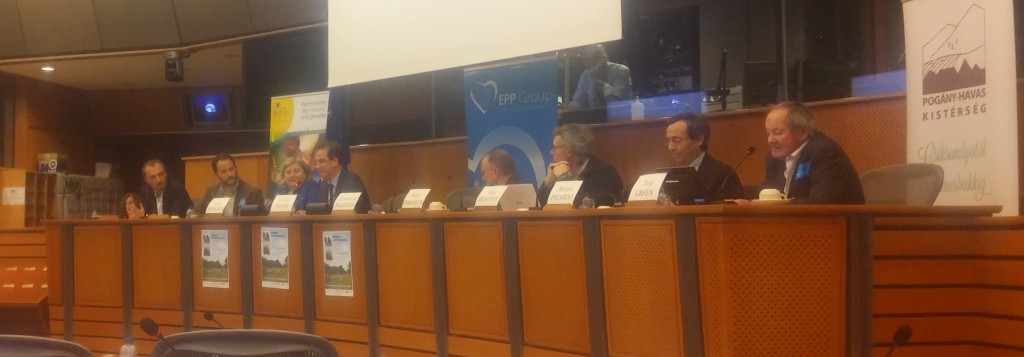Europe’s wood pastures: condemned to a slow death by the CAP?
Wood pastures – open woodland providing shelter and forage for livestock – cover several million hectares of farmland across the European Union, encompassing a range of environmentally valuable, agriculturally productive and culturally important landscapes. But just how many trees should a wood pasture have? It may seem like an odd question, but according to the EU’s Common Agricultural Policy (CAP), the answer is absolute: no more than 100 trees per hectare. Under the latest CAP rules, a pasture with 100 trees per hectare is perfectly eligible for direct payments. 101 trees however, and the land is ineligible for CAP support, even if it supports grazing livestock in exactly the same way.

The bizarre prospect of farmers counting and cutting down trees to align with an arbitrary rule was the most striking image of a seminar held on 17th November in the European Parliament to discuss the impacts of European policy on wood pastures across Europe. Europe’s wood pastures: condemned to a slow death by the CAP? was organised by the European Forum on Nature Conservation and Pastoralism, Pogány-havas Association and BirdLife Europe, with financial support from a number of organisations including the BES Forest Ecology Special Interest Group. The event brought together over 130 conservationists, scientists and policymakers from across the continent.
As Ted Green of the UK’s Ancient Tree Forum explained, wood pastures are unique semi-natural ecosystems whose sustainable blend of people, animals and trees has survived for thousands of years. Wood pastures provide a unique combination of ecosystem services: biodiversity, carbon storage, soil protection, water management and cultural value. Agriculturally, while generally low-yielding, they are productive, providing an example of High Nature Value farming and often producing locally specialised, high quality food.
How do EU regulations shape the management of wood pastures?
Two strands of European regulation govern the management of wood pastures. Two types of wood pasture – Fennoscandian wooded meadows and Mediterranean pastures with evergreen oaks (dehesas) – are protected under the Habitats Directive. However, the vast majority of wood pastures, as productive farmland, fall under the auspices of the Common Agricultural Policy.
Pillar 1 of the CAP provides economic support for farmers for all productive agricultural land, with a swathe of regulations determining what land is eligible. These payments offer crucial support for the maintenance of wood pastures, and in many ways, the latest round of CAP reform is a step in the right direction. Whilst previous rules defined pasture solely as grassland, actively discouraging the presence of trees and shrubs, these regulations have been amended such that all forage areas – herbaceous or woody – are eligible for payments, as long as vegetation is grazable, and in the case of wood pastures, where certain conditions are met.
It is here that we hit the aforementioned “100 tree limit”; 101 or more trees per hectare, and the whole parcel of land is ineligible for Pillar 1 payments. Member States do have flexibility to bend this rule by applying a system of pro-rata reductions in a pasture’s eligibility in proportion to the extent of “ineligible features”. The situation becomes even more complex if more than 50% of a pasture consists of trees and shrubs, when to be eligible for any payments Member States must receive special permission from the European Commission on the basis that it is representative of “established local practices”. While Pillar 2 of the CAP, covering rural development, could offer additional funding to support the maintenance of wood pastures, in practice only a few Member States have applied this option.
CAP on the ground: issues for farmers and the environment?
The CAP therefore creates a complex, bureaucratic and restrictive system for the management of wood pastures: how does this play out on the ground across Europe? The case studies presented at the seminar demonstrated the problems being created for both farmers and the environment.
In Spain, where 86% of pastures contain trees or shrubs, wood pastures constitute a key part of traditional farming systems, producing high quality products, sustaining rural economies, and providing valuable ecosystem services such as protection against forest fires. However, as Alvaro Picardo (Regional Government of Castilla y León) explained, the Spanish government’s interpretation of the new CAP regulations is having a severely detrimental effect on agricultural livelihoods. Farmers in some regions where wood pastures have traditionally dense tree cover have lost direct payments for up to 50% of their land, increasing the likelihood of pastures being abandoned.
In Romania, extensive wood pastures, with low density, often ancient trees, form a rich, unique ecosystem of importance for many protected species. And while the new CAP should allow these systems to be protected, they are threatened by inconsistencies in national interpretation. The crowns of trees and patches of shrubs are excluded from the area eligible for direct payments, incentivising farmers to cut down dead trees (living trees are protected) and remove shrubs: both critical components of these ecosystems.
A better future for wood pastures?
The take-home message of the seminar was that while the new round of CAP reform had the potential to deliver for wood pastures, unnecessarily restrictive and bureaucratic rules, which lead to inconsistent and inefficient implementation in different Member States, are creating barriers. Many speakers argued that simplifying the CAP rules for the eligibility of wood pastures for direct payments, based on use of land rather than vegetation type, would represent a step in the right direction. Will these changes be made? While the European Commission representative at the seminar was unforthcoming, the impressive range of conservationists, scientists and policymakers present in Brussels suggested that this is an issue which will remain on the agenda.
Find out more at the Remarkable Trees of Romania website
Like what we stand for?
Support our mission and help develop the next generation of ecologists by donating to the British Ecological Society.